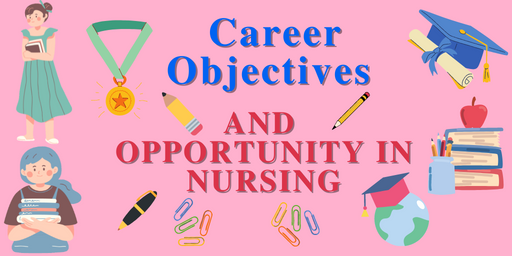Career Objectives and Opportunity In Nursing: explain how nursing career goals, nursing career objectives and nursing career educational pathway exist in this profession.
Career Objectives and Opportunity in Nursing: Scope of Nursing as a Career
Career Opportunity in Nursing
Nursing is a discipline, a profession, rich in opportunity and variety. Entry into the nursing profession offers a huge home, hospitals, nursing homes, industries, doctor’s offices, health centers, private practices, schools, colleges, universities, government, professional associations, and insurance companies, etc. Education for nurses is as diverse as the job. environments, certificate courses like ANM and LHV courses, diploma courses like GNM courses and courses or undergraduate courses like B.Sc courses like MN, MSc N, M Phil and also Ph.D. There are many courses in nursing education from certificate to diploma and diploma to diploma as well as diploma to master’s and doctoral degrees. There will be opportunities.
Dimensions of Educational Process in Nursing
Four dimensions have been identified in the educational process of nursing schools or faculties, among which are the following.
1: Content Dimension
2: Process Dimension
3: Ecological Dimension
4: Dimension of Human Relations.
1: Content dimension: It is related to what is taught and what is learned. This is called the curriculum. Curriculum refers to all content (knowledge, valuable skills) and learning activities planned and directed by a teacher for a specific group of students for a specific purpose. The nursing curriculum is concerned with providing opportunities to acquire the essential knowledge, skills, and attitudes that prepare the student to assume the roles, responsibilities, and functions in nursing at the level at which they are prepared.
2: Process Dimension: When referring to the “way” in which the teacher helps nursing students to learn. It includes the student, the groups of students (the class), the teacher and all the methods and procedures used by students and teachers.
3: Environmental dimension: Teaching includes spatial conditions such as classrooms, hospitals, rooms, departments, laboratories, health authorities, etc. and the sociopsychological climate due to the type of institution, administration, and staff organization, etc.
4: Human Relations Dimension: Includes all staff such as students, teachers, health workers, patients and others who may participate in the training of nursing students. The interaction (human relationship) of these people both at school/university and in educational settings outside of school/university has a major impact on the effectiveness of the educational process.
Interaction Among All Dimensions
The interaction of all these components or dimensions forms the educational process.
Nursing (basic), Bachelor of Nursing (after basic education), Bachelor of Nursing (IGNOU), MN/MSc Nursing, MPhil (N), PhD (N).
How to educate: It involves the knowledge and technique of different teaching methods to make the teaching-learning process dynamic, effective, and inspiring. Nursing education also has well-developed and practical teaching techniques, strategies and methods that are used both in the classroom and in clinical settings.
This book contains all the information about the nursing education process including objectives, educators, educators, educational environment, curriculum, teaching methods, etc., which will be discussed in detail in later chapters.
What is Career Objectives and Opportunity in Nursing?
Why Career Objectives and Opportunity in Nursing?
How Career Objectives and Opportunity in Nursing?
Read More:
https://nurseseducator.com/dialectic-teaching-with-team-based-learning/
https://nurseseducator.com/high-fidelity-simulation-use-in-nursing-education/
First NCLEX Exam Center In Pakistan From Lahore (Mall of Lahore) to the Global Nursing
Categories of Journals: W, X, Y and Z Category Journal In Nursing Education
AI in Healthcare Content Creation: A Double-Edged Sword and Scary
Social Links:
https://www.facebook.com/nurseseducator/
https://www.instagram.com/nurseseducator/
https://www.pinterest.com/NursesEducator/
https://www.linkedin.com/in/nurseseducator/
